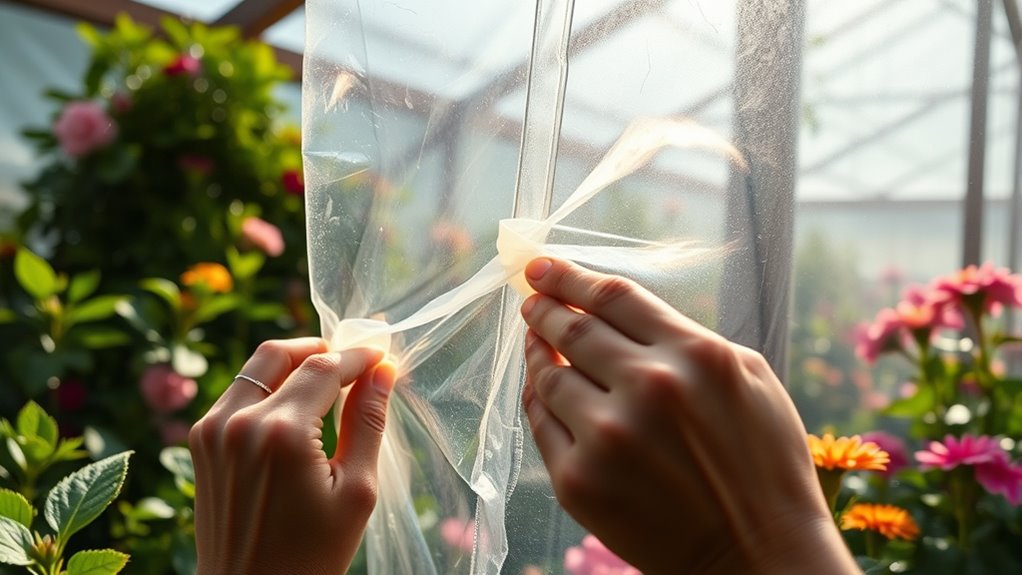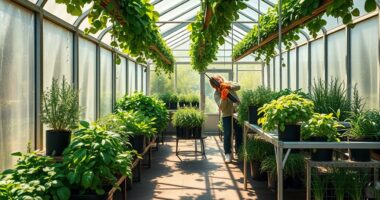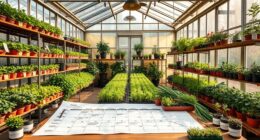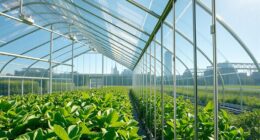To fix your greenhouse, start by sealing leaky panels with weatherproof silicone or repair tape, and keep gutters clear to prevent water damage. Check hinges and latches for rust or misalignment and replace or lubricate them as needed. Replace torn plastic sheeting with UV-resistant materials and secure with weatherproof fasteners. Maintain ventilation by cleaning fans and inspecting automatic vents. For irrigation issues, verify hoses, nozzles, and timers, and adjust as needed. Keep these tips in mind to keep your greenhouse in top shape.
Key Takeaways
- Regularly inspect and seal panels, cracks, and gaps with weatherproof silicone or repair tape.
- Lubricate hinges and replace damaged latches to ensure proper door and vent functionality.
- Remove and replace torn plastic sheeting with UV-resistant, outdoor-grade materials for effective insulation.
- Maintain ventilation systems by cleaning fans, lubricating moving parts, and testing automatic vents regularly.
- Check irrigation systems for clogs and leaks, adjust timers, and upgrade components for better water management.
Fixing Leaky Panels and Sealing Gaps
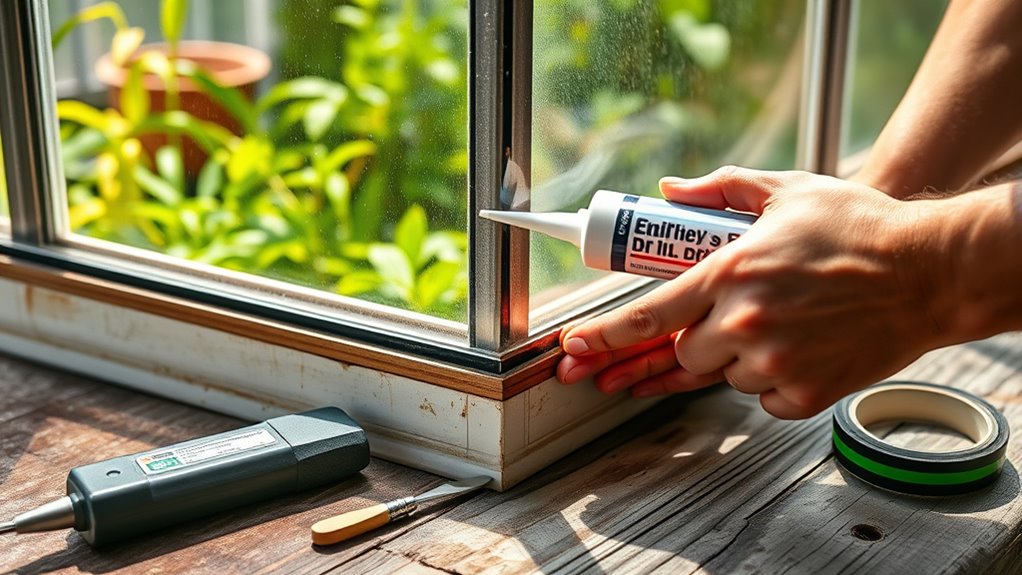
Leaky panels and gaps can quickly compromise the temperature and humidity control inside your greenhouse, so addressing them promptly is crucial. Start by inspecting all panels for cracks or loose fittings. Seal small gaps with weatherproof silicone or panel repair tape to prevent drafts and moisture loss. Utilizing proper sealing methods enhances the greenhouse’s overall efficiency and helps maintain optimal growing conditions. Proper gutter drainage is essential; ensure your gutters are clear and directing water away from the structure to avoid water seepage that can damage panels. Also, check that shelving units are stable, as unstable shelves can cause additional stress on panels, worsening leaks. Reinforce loose panels with appropriate fasteners or frame adjustments. Maintaining a stable structure is vital for preventing further damage and ensuring long-term durability. Regularly inspecting and preventing overspray from paint sprayers can help avoid unnecessary damage to your greenhouse surfaces. Additionally, understanding support hours for related services can assist in timely repairs and maintenance, ensuring that wall organization remains functional and effective.
Repairing Broken or Damaged Hinges and Latches
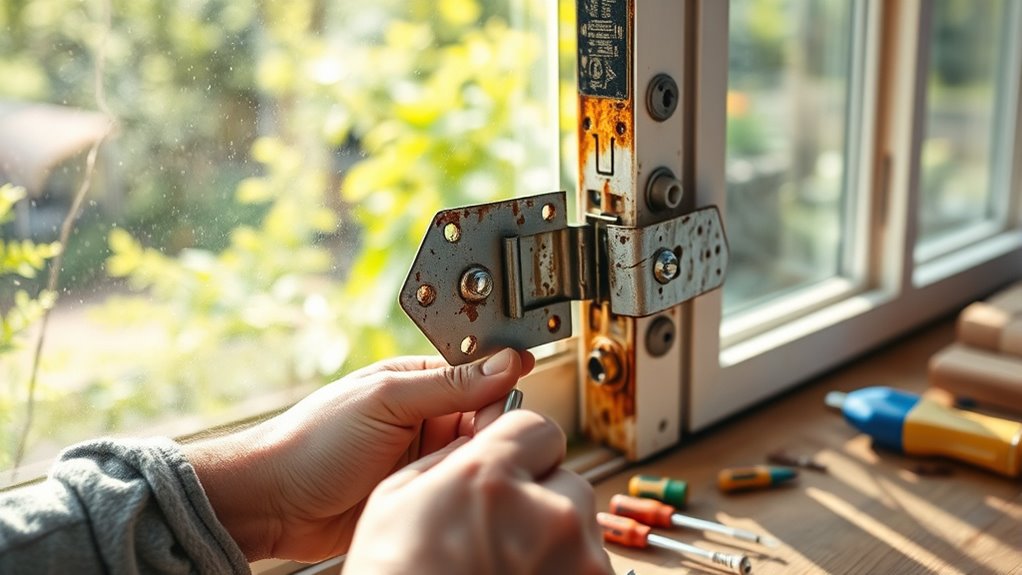
Hinges and latches are essential for secure access and proper ventilation in your greenhouse, but over time, they can become damaged or break, compromising both safety and climate control. To fix this, start by inspecting the hinges for rust or misalignment. Applying hinge lubrication can help them move smoothly again, preventing squeaks and further damage. Regular lubrication also minimizes wear and tear, extending the lifespan of your hardware. If a latch isn’t catching properly, try adjusting it by loosening or tightening the screws to ensure it aligns correctly with the catch plate. Sometimes, worn or bent latches need replacement. Using high-quality materials when replacing parts can improve durability and performance. Additionally, considering weather-resistant hardware can prevent future issues caused by the elements. Regular maintenance, including hinge lubrication and latch adjustment, keeps your greenhouse secure and functioning efficiently. Addressing these issues promptly prevents bigger problems and extends the life of your hinges and latches.
Replacing Torn or Damaged Plastic Sheeting
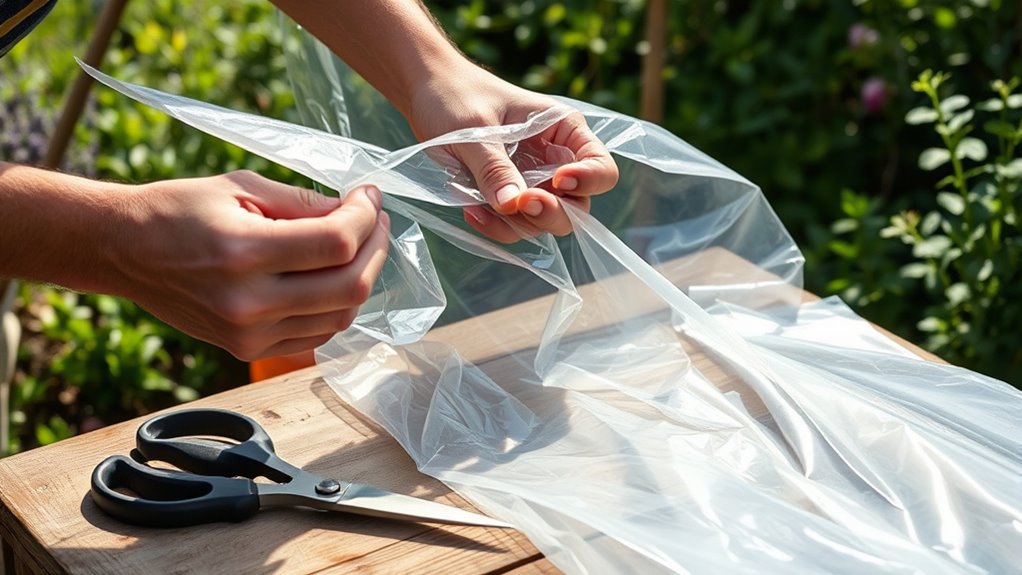
When plastic sheeting becomes torn or damaged, it can compromise your greenhouse’s temperature control and protectiveness. Replacing it is straightforward if you choose the right material.
Damaged plastic sheeting can compromise your greenhouse’s insulation and protection. Replace it with durable, high-quality material.
First, remove the old plastic sheeting carefully, cutting it away from the frame.
When selecting new plastic sheeting, consider factors like UV resistance, thickness, and clarity to ensure durability and light transmission. Opt for high-quality material suited for outdoor use, such as polyethylene or polycarbonate. Proper material selection is essential to maximize the lifespan and performance of your greenhouse cover. Additionally, choosing UV-resistant plastic can help prevent damage from sunlight over time. To ensure long-lasting repairs, research trending materials and technologies that enhance durability.
Measure your greenhouse accurately to cut the replacement sheet to size, leaving a little extra for secure fastening. Employing weather-resistant fasteners can further improve the durability of your repair.
Use appropriate fasteners like clips or double-sided tape to attach the new plastic tightly, preventing gaps and leaks.
Choosing the right material quality can significantly extend the lifespan of your greenhouse plastic sheeting and improve its performance over time. Proper installation techniques will also help maintain a sealed environment and protect your plants.
With proper material selection and installation, you can restore your greenhouse’s insulation efficiently.
Maintaining and Repairing Ventilation Systems

Are your greenhouse vents functioning properly? If not, it’s time to maintain and repair your ventilation system. Start by checking automatic vents: ensure they open smoothly and aren’t blocked or stuck. A well-maintained ventilation system can significantly improve climate control within your greenhouse. Regular inspections help prevent small issues from becoming major problems that could disrupt your plant environment.
A practical exercise can help you identify issues early on and keep your system in top shape.
Next, inspect ventilation fans for dust buildup or loose wiring. If needed, clean fan blades and tighten connections. Maintaining proper airflow is crucial for healthy plant growth and disease prevention.
Third, test the operation of automatic vents and fans regularly to prevent malfunction. Understanding the air circulation system can help you troubleshoot and optimize performance.
Finally, replace worn or damaged components promptly to avoid temperature control issues. Keeping your ventilation system in good condition ensures a stable climate and healthier plants.
Troubleshooting and Fixing Irrigation Issues
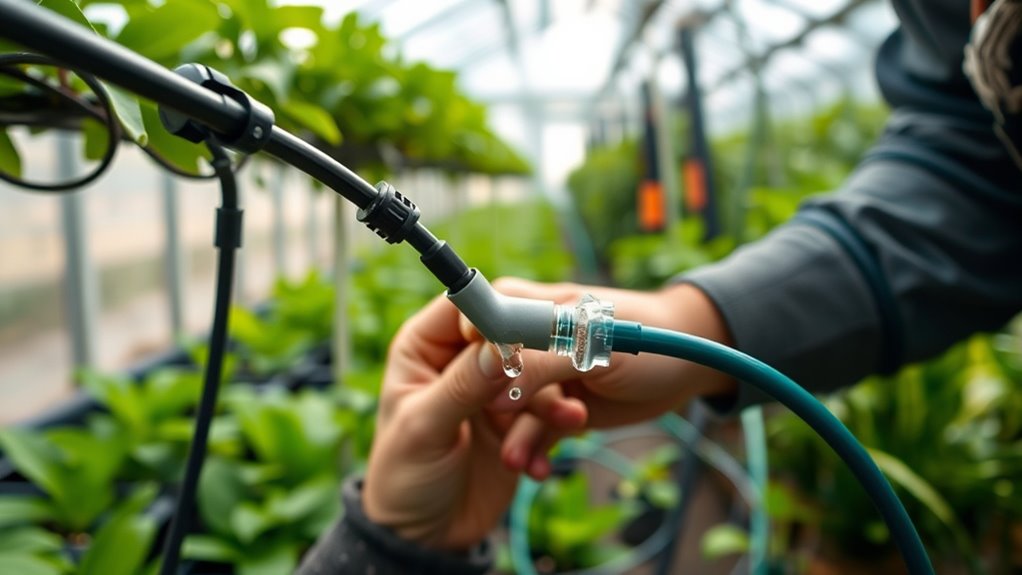
Irrigation issues can quickly disrupt your greenhouse’s environment, so diagnosing and fixing them promptly is essential. Start by checking soil moisture levels; uneven or overly dry soil indicates a problem with your watering system.
Ensure your watering schedules are appropriate for your plants’ needs—overwatering can cause root rot, while underwatering stresses your plants. Inspect hoses, nozzles, and timers for clogs, leaks, or malfunctions.
Adjust timers if necessary to match the correct watering frequency. If soil remains consistently dry despite watering, consider replacing damaged components or upgrading your system.
Regularly monitoring soil moisture and maintaining proper watering schedules help prevent irrigation failures. Modern irrigation systems with advanced filtration and humidity control features can further optimize watering efficiency. Quick fixes keep your greenhouse conditions stable, promoting healthy plant growth and avoiding costly damage.
Frequently Asked Questions
How Often Should I Inspect My Greenhouse for Repairs?
You should inspect your greenhouse at least once a week to catch issues early. Regular checks help you spot garden pest control problems and plant disease management needs before they escalate.
Look for damaged structures, leaks, or pests, and address repairs promptly.
Consistent inspections keep your greenhouse in top shape, ensuring ideal growing conditions and healthy plants.
Don’t wait for problems to worsen—stay proactive with your maintenance routine.
What Tools Are Essential for DIY Greenhouse Repairs?
When tackling DIY greenhouse repairs, you’ll need essential tools like a utility knife, screwdriver, and a caulking gun.
Keep greenhouse sealants handy for sealing leaks, and have replacement panels ready for any broken or damaged sections.
These tools help you efficiently fix cracks, replace panels, and guarantee your greenhouse remains weatherproof.
Regularly inspecting your structure makes repairs easier, saving you time and keeping your plants protected.
Can I Repair a Greenhouse in Winter?
You can absolutely repair your greenhouse in winter, but focus on winter maintenance and seasonal repairs suited for cold weather.
Choose milder days for outdoor work and make certain you have proper insulation to prevent further damage.
Use appropriate tools and materials, and prioritize repairs that protect your plants from frost.
Winter repairs may take longer, but addressing issues now keeps your greenhouse in top shape for the upcoming growing season.
How Do I Prevent Future Damage After Repairs?
To prevent future damage after repairs, you should regularly inspect your greenhouse for weak spots.
Use high-quality repair sealants to reinforce any vulnerable areas and make certain they’re properly applied.
Additionally, implement pest prevention strategies like sealing entry points and maintaining cleanliness.
These steps help protect your greenhouse from pests and weather damage, keeping it in good shape and extending its lifespan.
Regular maintenance is key to avoiding costly repairs down the line.
Are There Eco-Friendly Repair Options for Greenhouses?
You can choose eco-friendly repair options by opting for sustainable materials like recycled plastics, bamboo, or natural wood treatments.
Using natural remedies such as neem oil or vinegar can also address pests and mold without harmful chemicals. These options help maintain your greenhouse’s environmental integrity while ensuring durability.
Conclusion
With a little know-how, you can keep your greenhouse thriving all year round. Think of each repair as a small victory—your secret weapon against the elements. Don’t let leaks, broken hinges, or torn sheeting steal your garden’s magic. By mastering these DIY fixes, you turn challenges into opportunities, nurturing your plants and your confidence along the way. After all, a well-maintained greenhouse isn’t just a structure—it’s your personal paradise waiting to flourish.
